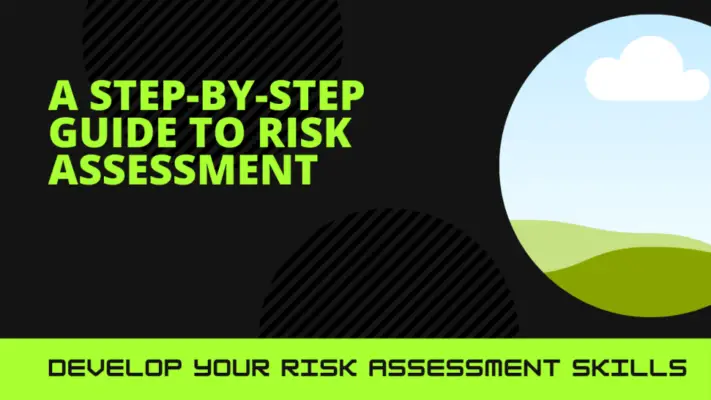Risk assessment is a component of project management aimed at identifying and evaluating potential risks that may impact the success of a project. It involves systematically analyzing uncertainties and their potential consequences to develop effective strategies for risk mitigation.
Project managers can better understand the potential risks and threats to their projects by conducting a thorough risk assessment. With this knowledge, they can make well-informed decisions and allocate resources effectively.
The first step in risk assessment is to identify all possible risks that could arise during a project. This includes internal factors such as changes in scope or resource constraints and external factors like market fluctuations or regulatory changes.
Once these risks have been identified, they must be evaluated based on their potential impact on the project’s objectives. This evaluation helps prioritize risks and determine which ones require immediate attention.
Following the evaluation phase, strategies for risk mitigation are developed. These strategies aim to minimize the likelihood of occurrence or reduce the negative impact of identified risks.
They may involve implementing contingency plans, transferring risks through insurance or contracts, avoiding certain activities altogether, or accepting them if they are manageable.
After developing the risk management plan, it needs to be implemented effectively throughout the project lifecycle. This requires clear communication and coordination among stakeholders in managing different risk aspects.
The success of a project heavily relies on a proper risk assessment procedure that allows for the prompt identification and reduction of any possible risks.
Project managers can ensure proactive decision-making and maintain overall project objectives using a detail-oriented approach. This involves analyzing uncertainties objectively and systematically organizing information about potential risks.

Identify Potential Risks
Identifying potential risks is a crucial step in risk assessment within project management, as it allows for anticipating and mitigating factors that could hinder project success, instilling a sense of preparedness and confidence in stakeholders.
Risk identification involves a systematic approach to identifying all possible risks that may arise during a project. This can be achieved through various techniques such as brainstorming sessions, historical data analysis, and consultation with domain experts.
Once potential risks are identified, they must be analyzed to understand their potential impact on the project objectives.
Risk analysis involves assessing each identified risk event’s probability of occurrence and severity. This helps prioritize risks based on their significance and enables effective allocation of resources for risk mitigation strategies.
In project management, conducting thorough risk identification and analysis is crucial to identify potential risks and ensure effective risk assessment.
Evaluate Impact on Project Objectives
Evaluating the potential impact on project objectives requires a thorough analysis of various factors and their potential consequences.
One crucial factor to consider is the project’s risk tolerance, which refers to an organization’s willingness to take risks during project execution.
Assessing the probability of risks occurring and their potential impact on the project’s objectives is essential. This evaluation allows project managers to prioritize risks based on severity and likelihood.
Project managers can assess and manage risks by assigning a numerical value or rating to each one. This helps them make informed decisions and plan effective risk mitigation strategies.
Additionally, evaluating the impact of potential risks helps determine whether certain objectives need adjustment or if alternative approaches should be considered.
This analysis ensures that projects are adequately prepared for possible setbacks and increases the chances of successful execution while minimizing adverse effects.

Develop Strategies for Risk Mitigation
To effectively manage potential challenges, it is crucial to develop proactive strategies that mitigate the impact of risks on project objectives.
Risk response strategies are designed to address identified risks and minimize their potential negative consequences.
These strategies can include:
- Risk avoidance, where steps are taken to eliminate the risk.
- Risk transfer, where responsibility for the risk is shifted to another party through contracts or insurance.
- Risk mitigation, where actions are taken to reduce the likelihood or severity of the risk.
- Risk acceptance, where it is determined that no further action is necessary due to a low level of impact or probability.
Effective risk management involves developing strategies and regularly monitoring and evaluating risks throughout the project lifecycle. This allows for early detection of any risk changes or their potential impact on project objectives.
Risk monitoring involves:
- Tracking identified risks.
- Assessing the status and effectiveness of implemented mitigation measures.
- Making adjustments as necessary.
Project managers can mitigate potential threats by continuously monitoring and updating their risk response strategies to remain aligned with evolving project circumstances.
Implement a Risk Management Plan
The successful implementation of a risk management plan is essential for ensuring a project’s overall success and stability. This involves effectively managing and addressing potential risks during the project’s lifecycle.
The first step in implementing a risk management plan is to identify risks. This includes identifying any potential threats or vulnerabilities that could impact the project’s objectives, resources, or timeline.
Once risks have been identified, the next step is to analyze them. This involves assessing the likelihood and impact of each risk on the project and prioritizing them based on their severity level.
To increase the chances of success for a project, project managers can develop effective strategies for mitigating and managing risks. This can be achieved by conducting a comprehensive risk identification and analysis process.
| Assess the likelihood and impact of each risk | Risk Analysis |
|---|---|
| Identify potential threats or vulnerabilities | Conduct a thorough analysis to understand the nature of the risks |
| Determine potential impacts on objectives, resources, timeline | Prioritize risks based on severity |
| Conduct a thorough analysis to understand the nature of risks | Develop appropriate strategies for mitigation |
Ensure Successful Project Delivery
Successful project delivery requires careful planning, efficient coordination, and effective execution of tasks and resources.
To ensure the successful completion of a project, it is imperative to improve communication within the project and establish effective mechanisms for monitoring and tracking project progress.
Effective communication is vital in keeping all stakeholders informed about the progress, challenges, and changes throughout the project lifecycle.
It enables timely identification and resolution of issues, promotes collaboration among team members, and ensures everyone is working towards the same goal.
Additionally, implementing robust project tracking and monitoring systems allows for real-time visibility into project performance metrics such as budget utilization, schedule adherence, and resource allocation.
This enables proactive identification of risks or deviations from the plan, allowing for timely corrective actions.
Organizations must prioritize enhancing project communication and implementing effective tracking and monitoring systems to ensure the successful delivery of projects. This requires a continuous effort to improve and implement strategies.
Frequently Asked Questions
How does risk assessment in project management differ from risk management?
Risk assessment in project management differs from risk management by focusing on identifying and analyzing potential risks, while risk management involves implementing strategies to mitigate or respond to those risks.
Risk assessment techniques are crucial for effective project planning and decision-making.
What are the key steps involved in conducting a risk assessment?
The key steps involved in conducting a risk assessment include: identifying potential risks, assessing the likelihood and impact of each risk, prioritizing risks based on their severity, developing mitigation strategies, and monitoring and reviewing the effectiveness of these strategies.
How can project managers identify all potential risks during the risk assessment?
Ensuring comprehensive risk identification in the risk assessment process can be achieved by implementing various risk assessment strategies.
These strategies may include brainstorming sessions, conducting thorough research, utilizing expert opinions, and analyzing historical data.
What factors should be considered when evaluating the impact of risks on project objectives?
When evaluating risks on project objectives, factors such as the potential magnitude of impact, likelihood of occurrence, and time sensitivity should be considered.
The alignment with project goals and available resources must also be assessed.
How can project managers effectively communicate the risk assessment findings to stakeholders?
Effective communication of risk assessment findings to stakeholders is crucial for stakeholder engagement.
Project managers should use clear and concise language, provide relevant data and evidence, and tailor the information to the stakeholders’ needs and preferences.
Conclusion
In conclusion, risk assessment is a crucial aspect of project management.
It involves identifying potential risks that may arise during the course of a project and evaluating their impact on project objectives.
Strategies for risk mitigation are then developed to minimize the negative consequences.
Project managers can ensure successful project delivery by effectively managing and mitigating potential risks by implementing a comprehensive risk management plan.
This detail-oriented, organized, and analytical approach to risk assessment is essential for achieving project success.

Chris Ekai is a Risk Management expert with over 10 years of experience in the field. He has a Master’s(MSc) degree in Risk Management from University of Portsmouth and is a CPA and Finance professional. He currently works as a Content Manager at Risk Publishing, writing about Enterprise Risk Management, Business Continuity Management and Project Management.

